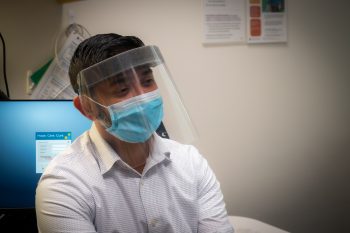
When a child is diagnosed with kidney failure, it can feel daunting and surreal. Often, patients feel like their life is put on hold. A child whose kidneys do not work normally may need dialysis to filter waste and extra fluids from the blood and, for those who suffer from kidney failure, dialysis is required. Dialysis is a lifesaving treatment, but it is also life-altering. Patients who need dialysis are on hemodialysis three to five times a week, a total of up to 12 to 20 hours per week.
Dialysis is a lifeline and bridge for many waiting for a kidney transplant, but it can take months or even years before an organ is available.

“There is no beating kidney failure,” Dr. Raj Munshi, medical director of Seattle Children’s Dialysis, said. “There is controlling kidney failure. It’s a lifelong fight. We care for a group of really courageous kids.”
Seattle Children’s has the only dialysis program specifically for children in the state of Washington and cares for children from all over the region, including Montana, Idaho and Alaska. Seattle Children’s Nephrology Program is among the best pediatric nephrology programs in the country.
The realities of dialysis
Hemodialysis requires doctors to gain constant access to the patient’s bloodstream. Doctors at Seattle Children’s have historically relied on placing a central venous catheter in the patient’s neck or chest, or creating a surgical fistula, which involves making a connection between an artery and a vein and typically requires a large incision made in the patient’s arm.
In the pediatric population, there have been problems with both techniques.
Surgical fistula creation is an invasive procedure that requires an incision that can cause scarring and requires longer recovery times for the patients. Even in the hands of a skilled surgeon, the surgical fistulas don’t work 40% of the time.
A central venous catheter, while less invasive, is more prone to infection and can cause damage to the central veins.
Despite many nephrology experts’ recommendations that fistulas are the preferred type of vascular access for dialysis patients, many patients at Seattle Children’s have been reliant on a central venous catheter for dialysis.
Safer care for children in renal failure
Dr. Kevin Koo, an interventional radiologist at Seattle Children’s, knew there had to be a better way to help children in renal failure. Until now, children who needed dialysis had no other options. They required dialysis, and so they had to undergo one of the two techniques.
He scoured medical literature and went to conferences in search of a solution. He knew there had to be a medical device or technique used in the adult population that could potentially benefit children as well.
Koo believes in doing what’s best for patients and was relentless in his pursuit for something to help his patients. Children in renal failure may be on a long waitlist to receive a kidney transplant, and their lives are drastically impacted by dialysis. It’s a reality that Koo wanted to minimize. At Seattle Children’s, providers believe in helping children thrive, which is one of the many things that drove Koo.
“When I see things that could be done better, it’s hard for me to stand by and do nothing,” Koo said. “I knew there was something in the adult population that we could make work for our patients, and so I gave it a shot. We couldn’t find a solution until now.”
A better way
Koo’s tireless efforts paid off. He advocated for the use of a device used in the adult population to help children at Seattle Children’s, and the hospital became the first pediatric hospital in the world to use a device to create a percutaneous arteriovenous fistula in order to provide lifesaving dialysis treatment to pediatric patients.
This innovative and alternative approach to care is helping to provide better outcomes and better care to a population that is traditionally underserved. The creation of a traditional fistula involves a complex surgery that can cause considerable discomfort and requires long recovery times. In contrast, the creation of a percutaneous fistula requires only a small needle puncture and catheter under ultrasound, without the need for incisions or stitches. It can be done in as little as 30 minutes, and the patient goes home with only a Band-Aid.
“I feel a lot of pride that we could get this to work in our patients,” Koo said. “It has taken a village to care for these kids, from the whole Interventional Radiology team, to the ultrasound department and the dialysis staff, and I’m so proud of the work that everyone has put in to make this program run.”
Koo and his colleagues have performed a handful of procedures using the device and have seen great results. The procedure is less invasive, is performed as an outpatient procedure, meaning they can go home the same day, and it has been very effective. Patients have now been able to remove their catheters and continue dialysis via their new fistulas.
Not only is this procedure helping to improve the quality of care, but it is helping to improve the quality of life for children as well. With a catheter, patients may feel like their world stops. Children are unable to partake in some of childhood’s joyful experiences, like taking a bath or swimming, and an invasive surgery can leave a scar for a lifetime.
“I think we can help a lot of patients using this device,” Koo said. “Our experience was driven by a desire for innovation with a focus on safety and efficacy. So far, what we’ve heard from our patients and families has been very positive.”
With the percutaneous fistula, children can do things they were never able to do before. The freedom to take a bath or go to the beach are a few priceless things they can gain.
Striving for the gold standard
Munshi is proud of his colleague and the team that cares for children on the Dialysis Unit.
“This technology existed, but we’re the first pediatric center to do it,” Munshi said. “The majority of kids on dialysis today have a catheter, but that doesn’t mean it’s what is best for kids.”
Munshi says this innovation will be incredibly meaningful for patients.
“The Dialysis Unit really encompasses our values of equity,” Munshi said. “It’s more than a word. We’re living our values. We care for a small group of patients. In total, our dialysis population is between 30 to 40 children. The total number is quite few but their needs are great. Kidney failure affects every part of your body and managing that is difficult. Kidney failure affects the minority group much more. Walk down to dialysis and you’ll see it’s multicultural and multiracial families, amazing stories of courage and fortitude. Because we care for so few kids, sometimes there isn’t a push for the technologies they need or innovative solutions, but here is a technology specific for the dialysis population, and it’s a gamechanger. We should be much more forceful to implement these things.”
Munshi hopes this story sheds light on a small but incredible population of children and highlights the incredible work of Koo and his unyielding determination to do what’s best for children. The whole team —nurses, social workers, child life specialists, dieticians, dialysis technicians, ultra-sonographers, the dialysis administrative team — are responsible for this great success, and Koo was the leader of innovation.
“This should be our North Star,” Munshi said. “We have to give the cutting-edge and best standard of care. We can’t cut corners. Providing the safest and best care possible is not where we end, it’s where our care starts.”

